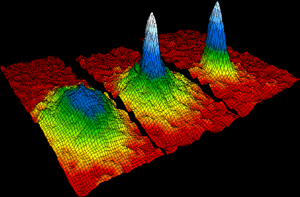Bose–Einstein condensate facts for kids
A Bose–Einstein condensate (often called a BEC) is a special state of matter. Imagine a gas that's super, super thin – about 100,000 times less dense than the air we breathe! Now, cool this gas down to an incredibly cold temperature, almost as cold as anything can get (that's called absolute zero, which is -273.15 °C).
When atoms in this gas get that cold, something amazing happens. Instead of acting like separate tiny particles, they all clump together and start behaving like one giant "superatom." This "superatom" can even be seen with the naked eye!
This cool idea was first thought up in 1924–1925 by Albert Einstein. He got the idea from Satyendra Nath Bose, who was working on a new field called quantum statistics. Einstein gave Bose full credit for this exciting discovery.
Contents
How the BEC Was Discovered

It all started when Satyendra Nath Bose sent a science paper to Albert Einstein. Bose's paper was about how tiny light particles (called photons) behave using something called quantum statistics. Einstein was really impressed! He even translated the paper into German and helped Bose get it published in a science journal in 1924.
Einstein then took Bose's ideas even further. He wondered if these quantum statistics could also explain how gas molecules might change when cooled. This led to the idea of a Bose gas. Particles that follow these special rules are called bosons. Einstein suggested that if you cool these bosonic atoms down to extremely low temperatures, they would all "condense" or fall into the lowest possible energy state. This would create a brand new form of matter.
For many years, scientists tried to create a BEC in their labs. Finally, on June 5, 1995, the first gaseous BEC was successfully made! This happened at the University of Colorado at Boulder by two scientists, Eric Cornell and Carl Wieman. They used rubidium atoms and cooled them to an incredibly low temperature of 170 nanokelvins. (A nanokelvin is a billionth of a kelvin, which is a unit of temperature!)
Soon after, Wolfgang Ketterle at MIT also made a BEC using sodium atoms. Because of their amazing work, Cornell, Wieman, and Ketterle won the 2001 Nobel Prize in Physics. Their discoveries opened up a whole new area of science called ultracold atoms. Today, many research groups around the world are still studying BECs.
Making a Bose–Einstein Condensate
To make a Bose–Einstein condensate, gas needs to be cooled to super-low temperatures. It's a tricky process!
First, scientists use special laser beams to cool the atoms. This makes the atoms almost stop moving. Then, they "catch" these super-chilled atoms in a magnetic field that acts like a bowl.
Using these methods, Cornell and Wieman were able to combine about 2,000 atoms into one "superatom." This "superatom" was big enough to see with a microscope and had very unique quantum properties.
Bose–Einstein condensates are very delicate. Even a tiny change in temperature can make them turn back into a normal gas.
What Scientists Are Researching Now
Bose–Einstein condensates are not just cool to look at; they have led to many new ideas and technologies.
One exciting idea is the atom laser. You know how a regular laser shoots out a beam of light particles (photons)? Well, an atom laser shoots out a beam of atoms! This kind of laser can be much more precise and accurate for certain tasks.
BECs have also shown that they can slow down light. A scientist named Lene Hau and her team at Harvard University managed to completely stop a pulse of light inside a BEC. They could even store the light and then release it later, completely unchanged, or send it to another BEC. This amazing ability could help us create new ways to send information using light, store data, and even build super-fast quantum computers.
Scientists are also making BECs from many different types of isotopes (different versions of atoms). In a new field called atomtronics, researchers are using the special properties of BECs to create new quantum technologies that work with "matter-waves" instead of light or electricity.
In 2020, researchers even announced they had created a BEC that was superconducting. This means it could conduct electricity with zero resistance!
Images for kids
-
Velocity-distribution data (3 views) for a gas of rubidium atoms, confirming the discovery of a new phase of matter, the Bose–Einstein condensate. Left: just before the appearance of a Bose–Einstein condensate. Center: just after the appearance of the condensate. Right: after further evaporation, leaving a sample of nearly pure condensate.
See also
 In Spanish: Condensado de Bose-Einstein para niños
In Spanish: Condensado de Bose-Einstein para niños


